First we took control of War. Next up was Death. After him came Fury. Now, it’s time to meet Strife.
When Darksiders first hit consoles and PC at the beginning of 2010, the creators weren’t shy about their hopes of turning their new, Biblical action-adventure game into a series. Now, ten years later, we’ve received the fourth game, which concludes the creators’ goal of releasing one game for each of the Four Horsemen of the Apocalypse, all of whom feature heavily in the franchise’s lore. Well, console gamers are. Darksiders Genesis is new to Xbox One, PlayStation 4 and Nintendo Switch, but it’s not exactly a brand new release, since it first debuted on PC a few months ago.
What’s most interesting about all of this is that each of the four aforementioned titles ended up being at least slightly different from one another. The original game — which still stands as the best of the bunch — was an incredibly immersive, action-packed and satisfying mixture of Zelda and God of War, which quickly became one of my favourite games of the generation. Then, when Darksiders II came out, it sent Death on a dungeon-heavy quest full of puzzles and loot, while also upgrading the combat. Years later, Darksiders III — which I never did end up finishing, because I struggled to get into it and didn’t enjoy its forced difficulty or reliance on backtracking — borrowed heavily from games like Dark Souls and Bloodborne, which are two series I do not like.
Now, ten years after the original debuted, we’ve received Darksiders Genesis; a game that is certainly the most different of all.
While Genesis doesn’t create a new genre, or exist as an entirely unique experience, it is very different from the three games that preceded it. That’s because, instead of being an action-adventure or third-person hack ‘n slasher, it’s a top-down dungeon-crawler akin to Diablo. This marks a noticeable change for the Four Horsemen, but it’s not a bad one. Although Genesis isn’t up to the level of Diablo III or Torchlight II, it’s a rather competent, well-made and enjoyable experience. Airship Syndicate — which is made up of former Vigil Games employees — has done a good job here, and fans should be pretty happy with the final result, even if it’s likely not what they’d expected from a Darksiders game.
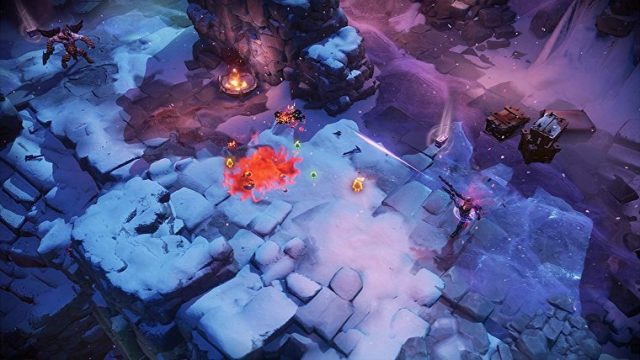
Things begin before the events chronicled in the first campaign, with news that Lucifer has been attempting to disrupt the all-important balance, by granting wishes to powerful demons in return for their loyalty. After dealing with a massive battle that ended with most of their kind being wiped out, the (Nephilim) Horsemen are given the task of discovering and thwarting the Devil’s devious plan. Only two are entrusted with this task, though, with those being War and Strife, the latter of whom hadn’t been a playable character in a Darksiders game until now. This provides the opportunity for some action-packed and enjoyable cooperative play through online or couch-based means, but also works well in the confines of single player gaming.
Those who decide to venture out alone will be able to quickly cycle between characters at will, and can do so by simply holding a shoulder button and pressing a particular face button at the same time. This works very well, and provides some nice variety, not to mention an extra life since a fallen Horseman doesn’t mean death so long as his brother can step in in his stead. Variety is the real draw here, though, because both War and Strife are different beasts. Whereas War prefers devastating, close-combat attacks, Strife is a much more agile and long-range fighter, thanks to two guns that can fire different kinds of bullets in quick succession. For instance, his regular bullets can be temporarily replaced by explosive or beam based fire, both of which can be charged up for extra damage. Both characters can utilize light and heavy melee attacks, though, and can deal quite a bit of damage through combos.
When you press the trigger button as War, he won’t fire any sort of gun. Instead, he’ll reach out into the distance and pull enemies towards him, which adds another layer to an impressive combat system, so long as that ability is equipped. This reach has a secondary benefit, in that it allows the two characters to grab onto and pull themselves towards objects in the sky. That becomes very important as the story progresses, because it’s often the only way to reach distant platforms. Sometimes puzzles will factor in, though, forcing you to climb to and pull certain levers in order to remove progression blocking barriers. Other times, you’ll have to jump from one vertical plinth to another, by jumping, grabbing on, moving around to the other side and then leaning out before jumping to the next one. Although the view is top-down, this all works fine for the most part. There are, however, times where the camera makes things a bit difficult. I’d be lying if I said that I hadn’t lost health from missing jumps, or not being able to tell where the next platform was, though those occurrences were not common or all that bothersome. When you fall, you’ll only lose a bit of health.
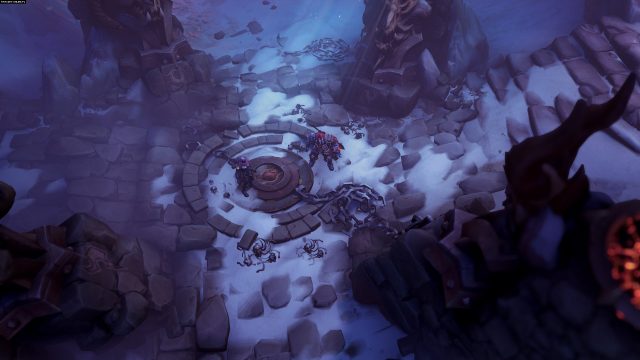
Both War and Strife can find, and employ, secondary weapons that will be familiar to folks who’ve played the other games. One such weapon is War’s vorpal blade, which acts like a boomerang and can be pretty handy when it comes to solving certain puzzles. Strife also gets a trusty void bomb, which allows for some portal-based fun. Those aren’t it, though. Throughout the game, you’ll come across numerous new abilities and special ammo types, all of which tend to be locked to certain characters. They’re helpful in a pinch, and can sometimes mean the difference between life and death.
While I appreciate all of the above, and think that the extra abilities add to the combat and game as a whole, their button assignments can be a bit confusing. It took me a while to get used to the controls, and the input combinations I’d need to use to employ certain powers. That said, the developers made up for this ‘issue’ by allowing the player to leave the button assignments list in the bottom right corner of the HUD. Those who don’t want to be annoyed by the on-screen text can toggle it off, but I found it helpful.
Speaking of powers, it’s important to mention that Wrath also features heavily within Darksiders Genesis. So, too, does a very powerful ultimate form ability, which is occasionally made available.
Wrath works similarly to how it did before, and is built up over time through traditional combat. Once you’ve filled the meter, Wrath is then unleashed, and allows for much more damaging attacks. If you’re using a special type of ammo, like the aforementioned beam and fire bullets, you’ll get their charged up attacks each time you fire.
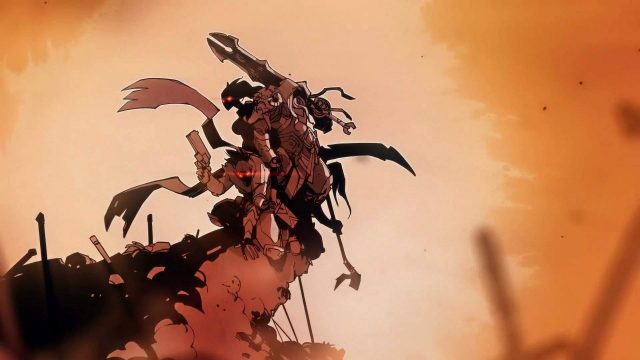
Although both Diablo and Darksiders II are known for their incredibly high amounts of loot, Genesis doesn’t bother with it as much. As such, you won’t pick up new weapons or pieces of armor after defeating enemies. Instead, the game’s healthy assortment of devious, dangerous and difficult foes drop orbs, which factor into the game’s somewhat convoluted skill tree. These orbs have different levels, and each one is tied to the type of enemy you defeated, so you’ll need to make sure to equip the right ones.
The orb tree is complex and requires several dialogue-based tutorial messages to explain. At its core, though, it’s a power grid. Each minor enemy orb you place powers the one beside it, allowing you to create branching networks of linked orbs. The goal is to fill all slots, with both basic and major (boss) orbs. All of them offer health, Wrath or ability buffs, and most will level up over time, as you defeat their specific enemy types.
Every placed orb will also factor into your overall power rating. It’s an annoying and unnecessary system, though, because it doesn’t do anything to improve the experience. Simply put, your power level is used to hint at whether (or not) you’re strong enough to tackle the next level. If not, it hints that you should revisit previous stages (or the Arena) to grind. This wasn’t appreciated, and became an issue halfway through the campaign, at which point I noticed I apparently wasn’t powerful enough to progress. At least, as far as the game thought and suggested. This was despite taking my time, killing many enemies and equipping quite a few orbs (once I discovered the skill tree hidden in the menus).
Orbs aren’t the only thing you’ll pick up, though. In true Darksiders fashion, enemies (and discovered chests) release souls, which can then be traded to Vulgrim and another shopkeeping demon for new perks and benefits. You can buy combos, orbs and objects that can increase the characters’ health bars (if four are collected), or up their Wrath abilities. Hell, you can also purchase the option of using more than just a couple of potions. Said potions are incredibly helpful when your health is low and death is imminent. They’re a literal lifesaver, and you can never have too many, which is why increasing the amount I could carry was the first thing I did.
That said, I didn’t need potions a lot early on. They were always nice to have, though, even on normal difficulty, as it’s not a walk in the park. It’s far from being as difficult as Darksiders III was, though, and is more user friendly. Those who want an added challenge can also up things to hard or apocalyptic if they please, and that is done through the game’s chapter (level) select screen.
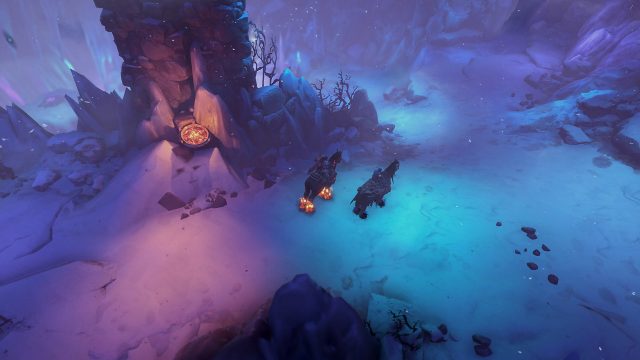
If you’re worried about length, you needn’t be. To start, Darksiders Genesis isn’t a full priced release. It’s also not short, as it’ll likely take you 10-13 hours to play through the game’s sixteen varied chapters, some of which are just boss battles. Levels are lengthy, their environments are often massive, and there are lots of things to find, including hidden chests and boatman coins. In fact, one of this game’s strengths is its level design, which is pretty impressive in its scale and its quality. There’s a good amount of variety, and those who like to go for everything will have a lot to do. It helps that the characters’ steeds are available for use, and can be called upon by simply pressing a couple of buttons. You can’t always use the horses, but they make traversing large landscapes easier.
That said, some stages feel a bit too big, and it can be easy to get lost. The maps you’ll find inside chests aren’t a great help, either, as they’re challenging to read and do a poor job of pointing one in the right direction. So, too, do each level’s lists of primary and secondary objectives.
After a while, you’ll also unlock the Arena. Therein, you’ll find ten survival challenges, which will pit you against increasingly difficult waves of enemies. As you’d expect, this is a great opportunity to grind for souls and orbs, and something that also adds replay value to the game. So, too, does the unlockable Apocalyptic difficulty that I mentioned above. It becomes available after you beat the final boss for the first time.
For the most part, Darksiders Genesis is a really well made and quality game. It’s fun, it’s action-packed and it has quite a few puzzles, which are sure to please those who love them. I, personally, do not, but they didn’t affect my enjoyment of this campaign. They felt necessary, and have always been a part of games like Zelda, God of War and Darksiders, even if they’re not my favourite part.
On the presentation side of things, one can expect a talking heads style of storytelling. War is his usual broody self, while Strife is a smart-ass who likes to poke fun at his brother and make light of the situation. Each of the demons also has its own personality, as does Vulgrim, who fans will be very familiar with. A lot of the storytelling is told through this style, although there are some moving comics-style cutscenes to watch as well.
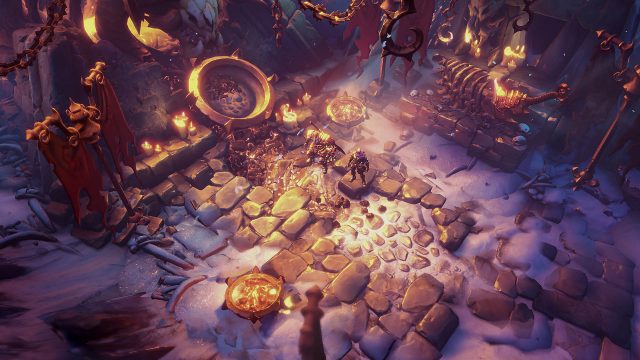
Things looked good, and performed pretty well during our time with the game on Xbox One X. That said, the framerate wasn’t perfect, and the game did crash once. It would slow down at odd times; even when there weren’t that many enemies on screen. Meanwhile, it would be okay during big fights and boss battles. The audio, on the other hand, was quite good. There’s a very solid orchestral soundtrack, some good voice acting, comical writing and solid storytelling to be found here.
The environments, themselves, are also quite varied, even though many are pretty Hellish in nature. Although this campaign will send you to the pits of hell, with stops at lava-filled forges, icy peaks and desert-style landcapes in-between, it always looks detailed and colourful. For this, the game’s art department deserves credit.
At the end of the day, Darksiders Genesis is another win for one of gaming’s more under-appreciated franchises. It’s a very solid hack ‘n slash dungeon crawler, and is a definite improvement over Darksiders III, which was by far the worst of the four. Its addition of co-op will be appreciated by those who like to play with friends, and this new style of gameplay will likely open the series up to a new audience. Sure, it’s not as good as Torchlight II or Diablo III, but is still a very worthy addition to the genre, and a purchase you can’t go wrong with.
This review is based on the Xbox One X version of the game, which we were provided with.

